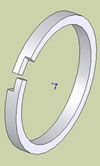Sealing the future
 One of the world’s leading race engine manufacturers has revealed their design philosophy regarding seals and gaskets to RET Monitor this month.
One of the world’s leading race engine manufacturers has revealed their design philosophy regarding seals and gaskets to RET Monitor this month.
Dave Salisbury, Chief Design Engineer at Engine Developments Ltd (EDL), told RET Monitor, “It’s a simple philosophy really… we just work hard to eliminate seals and gaskets wherever we can.”
Whilst that sounds straight forward and much like common sense it is actually something which is very hard to achieve and requires careful attention during the design stage of a project.
An FMEA (Failure Modes and Effects Analysis) of an engine will identify that where there is a joint there is a potential leak path with the inherent risk of a fluid leak, whether it be air, the working fluids (air / fuel charge or spent combustion gasses), coolant, fuel or oil.
The potential effects of fluid leakage are all extremely serious for a manufacturer such as EDL which bases its business on its reputation for performance and reliability in the Le Mans 24 Hours, as Salisbury explains, “With a season based essentially on one race there is very little room for seal or gasket failure in the schedule.”
We asked Salisbury what sealing issues EDL had been through recently on the LMP engine programme, “At Le Man this year we had no leakage problems whatsoever. In 2008 the engine was entirely leak free but we were nearly tripped up by a car installation issue. One of our LM P1 entries suffered from an oil hose coming loose which meant the car lost almost all of its oil. The driver saw the low pressure alarm and very sensibly cruised back round to the pits. Once the hose was re-fitted and the system refilled the engine ran OK and finished the race. It was still very lucky obviously as a major oil leak like that will often cause a crash.”
So leaks can cause fires, crashes and engine failures. They can also lead to disqualification at Le Mans as the ACO still test restrictor legality with the stall test; that is whereby with the engine idling the restrictor inlet is blocked. To pass the test the engine must stall. Salisbury continues, “When we started the LM P1 engine programme in the late 1990’s we looked closely at the sealing of the slide throttles and the airbox, as we had to ensure that designs which had worked well in Formula One would be up to the stall test. You don’t have to be quite so leak proof with these things in Formula One!”
Next month we will look further into EDL design philosophy before we get back on track with our examination of cylinder head gasket technology.
Written by Tom Sharp.